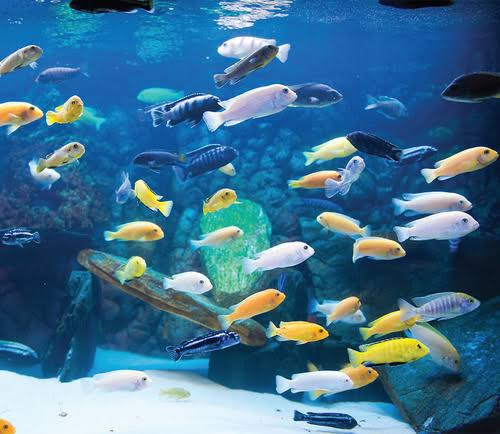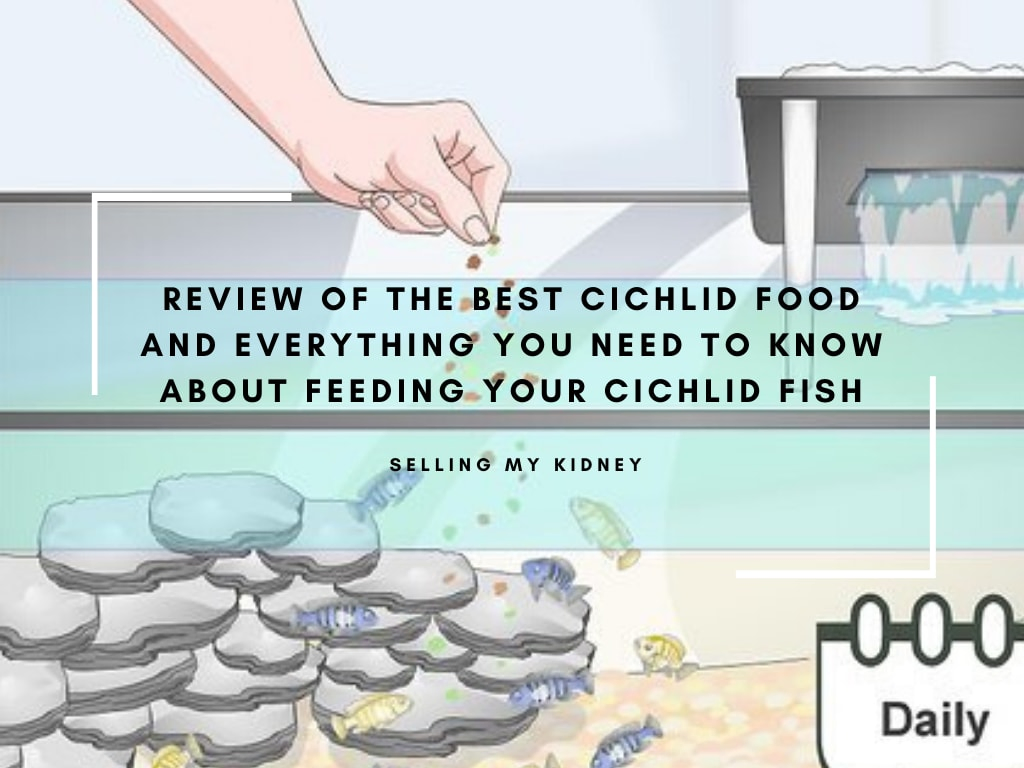Peacock Cichlids are a popular aquarium fish. Their striking colors and interactive personalities help them stand out among other freshwater fish.
Although some regard cichlids as a difficult fish to keep, it is relatively easy to keep these fish happy and healthy with a little background knowledge.
Are you ready to get a Peacock Cichlid?
How big is a Peacock Cichlid?
Thanks to Oscars, cichlids have a bit of a reputation for being freshwater giants that require enormous tanks. Thankfully, Peacock cichlids are much smaller in comparison.
The average size of a full-grown, male Peacock Cichlid is between 4 and 6 inches. Females are typically slightly smaller than males, but they are all around the same size.
What are the different types of Peacock Cichlid?

Although there are no significant size differences between the different types of Peacock Cichlid, there is quite a lot of variation in appearance between the different types.
Several different types of Peacock Cichlid have distinct colorations. Try to keep in mind that males will typically exhibit more vibrant colors than females.
Many of the females may sport some duller colored scales reminiscent of their male counterparts, but they often come off rather grey.
While not every variety of cichlid is available at your local pet shop, there are still quite a few popular cichlids you can spot on the market.
– Strawberry Peacock Cichlid

This specific variety hails from the southern waters of Lake Malawi. These beautiful fish have almost a hot pink coloration mixed with some white that will make them stand out in your tank.
Depending on the individual, they may even sport an elaborate pattern on their fins.
– Red Peacock Cichlid

The Red Peacock Cichlid has a deeper shade of red than the Strawberry Peacock Cichlid.
Unlike the latter, their red scales contrast with deep blue scales. They also typically sport stripes that run vertically along their bodies.
The combination of the bold white and blue makes it look more regal than other colorations. This variety is not found in the wild and is purely a product of selective breeding.
You may see them in stores referred to as “Ruby Red” or “Rubin Red” cichlids.
– Yellow Peacock Cichlid

If you are looking for something a little more neon, a Yellow Peacock Cichlid has bright, vibrant scales that are reminiscent of a highlighter.
Although it is not the easiest variation to find, it is easy to see why the fish sometimes dubbed as the “Sunshine” Peacock Fish is so sought after.
Their bright yellow scales can be contrasted by stripes or accents of white, blue, or slightly duller yellow scales.
– Blue Peacock Cichlid

The Blue Peacock Cichlid appears to have enhanced metallic scales and is an impressive metallic color.
This is easily one of the most popular varieties of Peacock Cichlid, and you can expect to observe some impressive variation between individuals of this variety.
Ranging from a bright blue to even a teal or yellow color, there is something for everyone to enjoy.
No matter what exact color they sport, you know that they will look impressive in a tank.
This is just the tip of the iceberg when it comes to cichlid varieties. There are currently over 20 identified varieties of the Peacock Cichlid.
These varieties are also able to crossbreed and create new color combinations that would never be found in the wild (much like the Red Peacock Cichlid).
More: Best Salt for Reef Tank
What is the habitat of a Peacock Cichlid?
Peacock Cichlids are native to East Africa. In general, cichlids as a species are found in Lake Malawi.
This giant lake is the ninth-largest in the world, providing a lot of room for cichlids to thrive in their own separate territories with other species.
Peacock Cichlids live at the bottom of the lake, scanning the warm waters for unlucky invertebrates that happen to pass by.
They are active swimmers who excel in their roles in their natural habitat of active hunters.
More: Best LED Aquarium Lighting
What are the tank requirements of a Peacock Cichlid?

When creating a tank for your fish, you should always aim to design a tank that mimics their natural environments.
Several different types of Peacock Cichlid have, there are a few conditions your tank must meet to provide an adequate home to your fish.
Peacock Cichlid Cheat Sheet | |
Temperature | 76°-82°F (24.2°-27.8°C) |
Tank Size | Min. 55G (208L) |
pH | 7.8-8-6 |
Hardness | 4-6dH |
Substrate | Sandy bottom |
Enrichment | Rocks/ Cave-like structures |
Temperament | Semi-aggressive |
Diet | |
Peacock Cichlid Tank Mates
Another bad reputation that cichlids have acquired is that they are incredibly aggressive. While this is true for some species, the Peacock Cichlid is relatively peaceful.
While they are friendly in comparison to other cichlids, it is important to note that they can be territorial (especially the males).
You must take the time to house your Peacock Cichlid with proper tank mates so that they can all live together in a happy community.
More: Best HOB Filter
Can you keep Peacock Cichlids together?
Peacock Cichlids can live together peacefully. In fact, it is what most experts recommend.
You should be sure to monitor the sex ration of your tank as this is a crucial detail that will determine how well your fish can actually live together.
Females of the species tend to have no problems with one another so that you can add as many females to the take as the individual: gallon ratio can handle.
When it comes to males -less is more. This can be a bit unfortunate as they are the ones with the nicer colorations, but this is the wiser decision to keep your tank happy.
Make sure there are enough females for the males to “share.” The ideal ratio in a tank is 1 male to every 4 females.
You also need to make sure that there are enough potential “territories.”
An individual male will often run off and “call” a cave-like area. They will live in and defend this territory and the females who encounter it.
When males have marked a specific portion of the tank as their territory, they will generally leave other males in the tank alone so long as borders are respected.
Can they be kept with other Cichlids?
Some other cichlids have a compatible temperament with the Peacock Cichlid.
Haplochromine Cichlids (Haps Cichlids) is one such smaller and tamer variety who should get along with the Peacock Cichlids in your tank.
Sadly, not all cichlids are gentle. Some of the more aggressive breeds (such as Oscars or Convict Cichlids) would spell trouble for the gentle Peacock Cichlids in your tank.
Be sure to do your research about the temperament of your fish before you add them to your aquarium.
This is something that can not be assumed by appearance alone.
What tankmates can be kept with a Peacock Cichlid?
As long as the fish are peaceful, a Peacock Cichlid can make an excellent addition to a community tank.
The bigger restriction in Peacock Cichlid tank mates is whether or not they can withstand the environmental preferences of the species.
You can try to add in some hardy, non-aggressive fish such as mollies or tetras.
There are also some other native fish that may be compatible such as the African Leaf Fish (or Spotted Climbing Perch).
It is very important to remember that these fish must be watched. Although Peacock Cichlids aren’t vicious, they are not always friendly.
Make sure to pay attention to the activity of your tank to make sure the cichlids are not bullying anyone.
When it comes to invertebrates, you’d best stay away. A Peacock Cichlid will see a passing shrimp or crab as nothing more than a tasty snack.
Most people find it easiest to keep cichlids in cichlid-only tanks.
How do I breed my Peacock Cichlid?
Breeding Peacock Cichlids is a relatively easy affair. Once you ensure you have at least one male and female, you can begin the process of breeding.
1. Make sure you have a “fry tank” ready. Most fish eat their babies so they must be separated while their offspring can grow up enough to live on their own.
It must be at least ten gallons, be heated to 76-82°F, and use a sponge filter. The fries don’t need a substrate, so leave it out for easier cleaning.
2. After males have established their territories, introduce females to the tank.
3. After some time, the males will exhibit breeding behavior. For a Peacock Cichlid, this means the male will dig a small ditch in the sand and try to lure females to his site.
4. If the female accepts, they will “court” each other. They perform a bit of a show where they swim over and around each other.
The female will drop eggs in the process, and the male will fertilize them externally. You should see the female will scoop up the eggs in her mouth. Do not worry, she is NOT eating them.
5. Watch the female over the next 2 weeks. She is carrying the eggs in her mouth to develop safely. During this “holding period,” she will barley open her mouth at all and eat almost nothing.
6. After about 2 weeks, the eggs are ready to hatch. Carefully place the female into the “fry tank” you set up.
7. Feed the Peacock Cichlid fry a liquid diet and live baby brine shrimp. As they get bigger, you can transition them to an easier diet.
Many hobbyists find that their Peacock Cichlids end up breeding on their own accord and discover babies floating in their tank after some time.
They are considered a very easy fish to breed.
Is a Peacock Cichlid right for my aquarium?
If you are looking for a gentle and colorful cichlid to add to your tank, Peacock Cichlids may be the perfect fit for you.
Taking the time to secure and appropriate environment and learn a little bit about the species can make cichlid-keeping less complicated.
Would you like to share about your experiences with cichlid keeping? Feel free to comment below with any questions or anecdotes about your cichlid tank!



